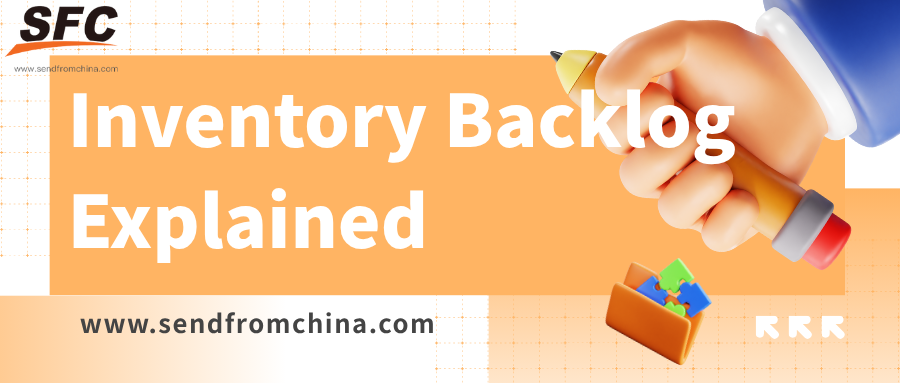Table of Contents
Inventory Backlog Explained: Definition, Formulas, and Prevention Strategies
Time: Jul 23,2025 Author: SFC Source: www.sendfromchina.com
Inventory backlog isn’t just a warehouse hiccup—it can stealthily undermine cash flow, stall order fulfilment, and frustrate customers at scale. As you grow, it’s not if you’ll face backlog—but when.In this post, you’ll discover what inventory backlog really means, how to measure it using proven formulas, and why it happens in the first place. We’ll also unpack the hidden costs of excessive backlogs and equip you with a strategic toolkit to prevent and resolve them—whether you're battling seasonal surges or operational bottlenecks.
Let’s dive in and turn what seems like a crisis into a catalyst for smarter inventory management.

1. What Is an Inventory Backlog?
Inventory backlog—also called unfinished orders or pending shipments—is the count of customer orders that remain unfulfilled. Think of it as a queue: customers have paid or placed orders, but you haven't shipped yet. Convert that to financials, and it’s revenue on the ledger, not yet in customers’ hands.Backlogs aren’t inherently bad. When they rise due to surging demand or strategic pre-orders, they reflect strong market reception. Yet if they persist or keep climbing, they signal deeper supply‑side dysfunction.
Some definitions aim too narrowly—law firm jargon defines "Inventory Backlog" as a reported pending order tally. But for supply chain and order fulfillment teams, it’s anything sold but not shipped.
2. Why Does Inventory Backlog Happen? (The Root Causes)
Understanding root causes helps you turn symptom-catching into system-fixing. Here are the most common, nuanced reasons behind inventory backlogs:2.1 Demand-Driven Surges
Unexpected spikes in customer demand—whether stirred by viral campaigns, influencer hype, or unanticipated seasonal variations—can quickly overwhelm your fulfillment capacity. Known as demand surges, these events push your systems, warehouses, and logistics partners beyond their bandwidth, resulting in piling orders that can’t be processed fast enough.Related Phenomenon: The Bullwhip Effect
Misaligned forecasts and batch ordering lead to ripple amplitudes in production, causing upstream supply nodes to overreact to downstream demand signals. This magnifies variability in stock, elongating lead times and amplifying backlogs.
2.2 Supply-Side Bottlenecks
Globalized supply chains are intricate webs prone to disruption. From factory downtime to port congestion, trucking hurdles to customs delays—any hiccup reverberates as unfulfilled upstream orders. As a result, even if your demand forecast is accurate, materials or finished goods may not arrive in time to close open orders.These interruptions often couple with transparency issues: poor visibility into supplier pipelines prevents early detection and response, deepening backlog accumulation.
2.3 Internal Process Failures
Operational kinks—like equipment malfunction, lack of alternative packing stations, or inefficient warehouse layouts—can slow throughput. When fulfillment bottlenecks crop up, orders accumulate downstream.For instance, frequent shelf replenishment delays can account for up to 90% of retail stockouts, underscoring how internal disorganization can be a major backlog driver.
2.4 Inventory Inaccuracies & Phantom Stock
Data inconsistencies between recorded stock and physical inventory lead to overselling available items. Such phantom inventory is usually caused by:- Human errors: miscounts, double scans, mislabeled SKUs
- System issues: broken integrations, missing syncs
- Shrinkage: theft, expiry, damage
Even small variances can snowball into large backlog episodes—making accuracy a frontline defense.
2.5 Inaccurate Forecasting
When demand forecasting misses the mark—whether due to outdated methods, insufficient seasonality insights, or incomplete market data—you risk stocking too little. Type consequences:- Unplanned out-of-stocks
- Backorders piling up waiting for replenishment
- Backlogs buried behind supply-chain outages
2.6 Supplier Misalignment & Governance Gaps
An imbalanced relationship with suppliers—characterized by one-way forecasts, weak communication, or absence of vendor-managed inventory (VMI)—can cause misaligned production schedules. Without transparent, structured arrangements, suppliers may fail to prioritize your orders during surges, exacerbating backlog buildup.2.7 Complex Multichannel Operations
Managing stock across DTC, marketplace, brick-and-mortar, and international warehouses introduces friction. Failing to rebalance or share inventory data can leave one channel stocked while another fails, triggering localized backlogs that reinforce others.2.8 Order Batching & Lead Time Variation
Batch ordering—done to save transportation or production costs—creates episodic demand versus steady flow. This leads to stock spikes when batches arrive and droughts between replenishments. Longer, lumpy lead times only magnify this — fueling backlog cycles.2.9 Theft, Shrinkage & Damage
Sometimes goods simply “disappear”—due to internal employee theft, shipping loss, spoilage, or damage. These unrecorded losses create system-level overstatements of inventory, which later translate into undeliverable orders and consequent backlog.3. How to Measure Backlog: Formulas That Reveal the Impact
Measuring backlog isn’t just about tracking numbers—it’s about turning data into insight. Here’s how to approach it with precision:
Core Formula: Inventory Backlog (Units)
Inventory Backlog = Total Committed Units – Units Shipped- This foundational metric gauges how many orders are outstanding.
- Use at both the SKU level and overall—this granularity helps identify problem SKUs versus order volume ones.
Backlog Ratio (by Units or Value)
Backlog Ratio = Current Backlog ÷ Total Orders (or Sales)- Expresses what fraction of orders remain unfulfilled.
- Choose unit-based (e.g., 200 units backlogged ÷ 1,000 total orders = 20%), or value-based (e.g., $50K backlog ÷ $500K sales = 10%).
- A rising backlog ratio signals mounting capacity issues.
Days of Inventory Backlog (DIB)
DIB = Current Backlog (Units) ÷ Avg Daily Fulfillment Rate- Converts stuck orders into time, e.g., “We've 5 days of backlog worth of process load.”
- Offers practical insight into expected customer wait times.
Sales Backlog in Days
Sales Backlog Days = Total Backlog Value ÷ (Quarterly Sales ÷ 90 days)- Translates backlog into a timeline: e.g., “45 days of committed sales waiting delivery.”
- Especially useful for financial analysis and planning.
Inventory Turnover Ratio & Days in Inventory (DSI / DII)
- Inventory Turnover = COGS ÷ Average Inventory- Days Sales of Inventory (DSI) = (Average Inventory ÷ COGS) × 365
- High turnover / low DSI → leaner operations, less risk of backlog. Low turnover/high DSI → excess stock, potential backlog triggers.
Reorder Point & Safety Stock Calculations
- ROP = (Avg daily usage × Lead time) + Safety stock- Safety Stock = (Max daily usage × Max lead time) – (Avg daily usage × Avg lead time)
- Ensures timely replenishment—key prevention of incoming backlog.
Weeks or Months of Backlog (Workload Assessment)
For facilities or 3PL operations:- Backlog in Crew-Weeks = Total Work Hours Backlogged ÷ Crew Capacity per Week
- Months in Backlog = Total Units Backlogged ÷ Monthly Throughput
- Reveals whether resource capacity aligns with backlog demand.
Backlog Ratio (Project / Kanban Style)
A nuanced view from project management:Backlog Ratio = (Lead Time – Avg Cycle Time) ÷ Avg Cycle Time
- Indicates how long items linger vs actual processing time.
- Useful when orders vary drastically in size or processing complexity.
4. Risks and Hidden Costs of Excess Backlog
When inventory backlog becomes excessive, it’s no longer just an operational hiccup — it’s a strategic risk that bleeds value across your business.
Customer Experience & Reputation Damage
- Longer wait times frustrate modern consumers who expect fast shipping and reliable updates.- Resulting in negative reviews, reduced lifetime value, and potential loss of future sales.
- As noted, “one frustrated customer doesn’t just represent one lost sale—they represent lost lifetime value, negative word‑of‑mouth marketing, and potentially damaging online reviews…”
Working Capital Drain (Braided Capital)
- Orders in backlog represent revenue on paper, but revenue unrealized—tying up funds in inventory that hasn't moved or been paid for.- These “dead capital” reserves reduce liquidity for new investments or operations.
Increased Carrying & Holding Costs
- Holding unsold inventory incurs ongoing expenses such as warehousing, security, insurance, and utilities.- Wikipedia estimates carrying costs range from 20–30% of inventory’s total value.
- For instance, a $100,000 backlog can cost $20–30k annually—just in storage.
Opportunity Cost & Obsolescence Risk
- Stagnant inventory crowds out working capital that could fund faster-moving, higher-margin items.- As Sassetti notes, manufacturers risk stock obsolescence without nimble turnover.
- The longer items linger, the more likely they lose value or become unsellable.
Operational Inefficiency & Complexity
- Excess backlog often leads to order splitting, manual workaround processes, and equipment/space strain.- FasterCapital highlights the chaos: “backorder backlog is a common problem… companies can clear the path to efficient order fulfillment…”
Supply Chain Disbalance & Bullwhip Effect
- Backlogs can ripple upstream, exacerbating demand swings and prompting bloated purchases — the notorious bullwhip effect.- This thwarts lean inventory practices and worsens inventory swings.
Rush Costs & Premium Freight
- To clear backlog quickly, firms may resort to air freight, expedite charges, or overtime labor — all of which inflate cost-per-unit.- According to FasterCapital, “Backorder costs can include additional shipping and handling fees …”
Lost Sales & Substitution Effects
- Stockouts and backorders often drive customers to competitors or alternate products—retailers lose ~4% of sales due to out-of-stock scenarios.- At the very least, loyalty is eroded and competitors gain.
Service & Support Overhead
- Chronic backlog sparks increased customer service interactions, status updates, and order tracking requests — all labor-intensive.- Additionally, returns, cancellations, refunds, and reorders burden finance and operations teams.
Financial & Reporting Distortions
- Backlog inflates reported sales or revenues temporarily but masks real cash flow impediments.- While revenue may seem strong on paper, it hasn’t been realized—potentially misleading stakeholders.
5. Preventing Inventory Backlog: Strategy Suite
Managing inventory backlog proactively requires a multi-layered strategy. Here’s a robust suite of prevention techniques to put you ahead of the curve:
Enhance Supply Chain & Inventory Visibility
- Real-time transparency into stock, production, and shipping status allows early detection and quick mitigation of potential delays. Tools like ERPs, WMS with barcode/RFID scanners, and advanced shipment tracking dashboards significantly reduce blind spots.- Example: GoComet provides end-to-end visibility across all transport modes—allowing proactive actions before delays escalate.
Use Data-Rich Demand Forecasting & Replenishment
- Blend historical sales, seasonality, marketing plans, and external trends. Employ AI-powered predictive models to detect patterns and demand shifts—used extensively by Walmart, Target, and Home Depot.- Implement systems that auto-trigger requisitions based on reorder points and safety stock formulas.
Categorize Inventory (ABC Analysis)
- Segment inventory into A (top value), B (mid), and C (low) categories. Focus forecasting, safety stock, and supplier partnerships on A-items; automate C-item management.Strengthen Supplier Partnerships & CPFR
- Collaborative Planning, Forecasting, and Replenishment (CPFR) enables synchronized production and delivery by sharing demand forecasts and status updates with suppliers.- Keep multiple or backup vendors for mission-critical SKUs (top 20%) to avoid disruptions.
Implement Automated Replenishment & Alerts
- Use systems to continuously monitor inventory and auto-reorder when thresholds are reached.- Set notifications for lead time deviations, safety stock dip alerts, and dynamic triggers to minimize manual oversight gaps.
Adopt Just-in-Time (JIT) & Agile Principles
- Strive for lean inventory—ordering to match real-time demand reduces carrying costs and risk of backlog.- Use cross-docking for fast-moving A-items to cut handling time and storage needs.
Continuous Inventory Reviews & Optimization
- Adopt continuous review systems that flag anomalies immediately.- Conduct regular inventory audits and aging reviews to identify slow-sellers or variants prone to causing delays.
Route Planning & Peak-Season Prep
- Analyze historical peak data to buffer lead times and expand staff/capacity ahead of sales surges.- Optimize logistics: use alternate ports, flexible 3PL agreements, and automated rerouting to dodge bottlenecks.
Invest in Technology & Mobility
- Adopt barcode scanners, RFID, WMS, and intelligent invoice/audit systems to streamline processes, reduce errors, and accelerate fulfillment.Build Buffer Capacity & Strategic Fulfillment
- Keep a buffer crew of pickers, packers, or partner 3PLs on standby during demand surge.- Negotiate surge clauses in 3PL contracts to scale storage or distribution dynamically without costly delays.
6. How to Resolve an Existing Backlog
When you already have a backlog that needs clearing:Prioritize Orders – Based on urgency, value, deadlines.
Fast-track Fulfillment – Use short-cuts like overtime, dedicated packing gangs, outsourcing excess labor.
Outsource Logistics – Third-party logistics partners can absorb spikes and clear backlog faster.
Communicate Transparently – Keep customers in the loop with ETA, partial shipments, or alternative items.
Return Unsaleables to Vendor – Clean obsolete or nonmoving SKUs with supplier buyback arrangements.
7. Conclusion
Inventory backlog is not a defeat—it’s a signal.If understood, measured, and managed through smart strategy, it becomes an opportunity to sharpen systems, satisfy customers, and scale sustainably. At SendFromChina, we integrate forecasting, logistics, and full fulfilment support to keep your inventory agile, responsive, and ready—no backlog necessary.
8. FAQs
Q1: Is every backlog bad?
A: No. A small backlog can signal strong demand. It only becomes problematic when shipments lag and customer satisfaction drops.Q2: How often should I calculate backlog?
A: Aim for daily or weekly. For fast-moving e‑commerce, daily tracking is essential.Q3: What’s the difference between backorder and backlog?
A: Backorder: specific SKU is out-of-stock. Backlog: accumulated orders not shipped yet.Q4: Can promotions help reduce backlog?
A: Yes—especially with slow-moving SKU backlog. Discounts, bundles, and returns are effective liquids.Q5: Does safety stock cause backlog?
A: Not if managed well. Safety stock buffers unexpected demand or delivery delays—but excess safety margins can tie up capital and distort reorder logic Post Views:2271
Post Views:2271
Copyright statement: The copyright of this article belongs to the original author. Please indicate the source for reprinting.
Previous Post
What Is Automated Order Fulfillment? A Complete Guide for 2025
Next Post
Supply Chain Quality Matters: Top KPIs, Challenges & Optimization Strategies
TAGS
Hot Research
Get a Custom China Fulfillment Solution with FREE Storage for 30 Days
 Want to know about our services, fees or receive a custom quote?
Want to know about our services, fees or receive a custom quote?
 Please fill out the form on the right and we will get back to you within a business day.
Please fill out the form on the right and we will get back to you within a business day.
 The more information you provide, the better our initial response
will be.
The more information you provide, the better our initial response
will be.





 TAGS:
TAGS: